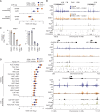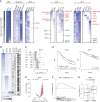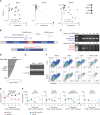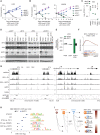Transcriptional Heterogeneity Overcomes Super-Enhancer Disrupting Drug Combinations in Multiple Myeloma
- PMID: 37767768
- PMCID: PMC10772542
- DOI: 10.1158/2643-3230.BCD-23-0062
Transcriptional Heterogeneity Overcomes Super-Enhancer Disrupting Drug Combinations in Multiple Myeloma
Abstract
Multiple myeloma (MM) is a malignancy that is often driven by MYC and that is sustained by IRF4, which are upregulated by super-enhancers. IKZF1 and IKZF3 bind to super-enhancers and can be degraded using immunomodulatory imide drugs (IMiD). Successful IMiD responses downregulate MYC and IRF4; however, this fails in IMiD-resistant cells. MYC and IRF4 downregulation can also be achieved in IMiD-resistant tumors using inhibitors of BET and EP300 transcriptional coactivator proteins; however, in vivo these drugs have a narrow therapeutic window. By combining IMiDs with EP300 inhibition, we demonstrate greater downregulation of MYC and IRF4, synergistic killing of myeloma in vitro and in vivo, and an increased therapeutic window. Interestingly, this potent combination failed where MYC and IRF4 expression was maintained by high levels of the AP-1 factor BATF. Our results identify an effective drug combination and a previously unrecognized mechanism of IMiD resistance.
Significance: These results highlight the dependence of MM on IKZF1-bound super-enhancers, which can be effectively targeted by a potent therapeutic combination pairing IMiD-mediated degradation of IKZF1 and IKZF3 with EP300 inhibition. They also identify AP-1 factors as an unrecognized mechanism of IMiD resistance in MM. See related article by Neri, Barwick, et al., p. 56. See related commentary by Yun and Cleveland, p. 5. This article is featured in Selected Articles from This Issue, p. 4.
©2023 The Authors; Published by the American Association for Cancer Research.
Figures







Comment in
-
Transcriptional Plasticity Drives IMiD and p300 Inhibitor Resistance in Multiple Myeloma.Blood Cancer Discov. 2024 Jan 8;5(1):5-7. doi: 10.1158/2643-3230.BCD-23-0223. Blood Cancer Discov. 2024. PMID: 38085608 Free PMC article.
References
-
- Fonseca R, Barlogie B, Bataille R, Bastard C, Bergsagel PL, Chesi M, et al. . Genetics and cytogenetics of multiple myeloma: a workshop report. Cancer Res 2004;64:1546–58. - PubMed
-
- Chesi M, Bergsagel PL, Shonukan OO, Martelli ML, Brents LA, Chen T, et al. . Frequent dysregulation of the c-maf proto-oncogene at 16q23 by translocation to an Ig locus in multiple myeloma. Blood 1998;91:4457–63. - PubMed
Publication types
MeSH terms
Substances
Grants and funding
LinkOut - more resources
Full Text Sources
Medical
Molecular Biology Databases
Miscellaneous

